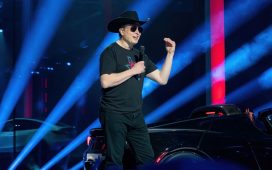The proliferation of electric vehicles and charging stations in the coming years could alter the relationship between drivers and where they park.
Paul Vosper, CEO of EV charger manufacturer JuiceBar, said that as the vehicle charging network becomes more robust, it creates the potential for a new “vehicle-to-building” system, meaning that while an electric vehicle is sitting idle, its battery can be used to help power a building.
“I suspect that what we’re going to see in the future is buildings competing for EV drivers, saying if you park with me today, I’ll pay you $14 or whatever the number is,” Vosper said. “If they look at the weather forecast and see it’s going to be a hot day tomorrow, paying them to park in my building and making their battery available to me is going to help me on my electric bill.”
Vosper, 55, spoke with Reporter John Irwin about the future of EV charging and how the network might be built up in the coming years. Here are edited excerpts.
Q: What would it take technologically to enable a building to run off power from EV batteries, and is that possible to do today?
A: It is available today, but mainly in the fleet market. School buses are being designed to be bidirectional.
We have been building our chargers with bidirectional, utility grade meters, which means we can very precisely measure the flow of power into the vehicle and from the vehicle. We are launching … precursor software needed to communicate bidirectionally with the EV.
The next step is for the automakers to support that with hardware and software in the vehicles. The original concern was battery degradation, but what we are finding is that batteries don’t degrade because of charging cycles as much as keeping the battery fully charged and fast charging/fast discharging.
Using Level 2 AC charging and discharging is really not a big issue for battery degradation.
It seems now that most, if not all, of the EV manufacturers will support bidirectional charging. We see [vehicle-to-building] as the most likely first application of this technology, but it would be tremendously useful to peak shave the grid for utility companies.
In January, JuiceBar unveiled its first home charger. How will the commercial and home charging markets evolve over the next several years?
We’re going to let the market determine what type of charger they want, whether that’s commercial or residential. There are some issues in the U.S. with residential charging. A lot of legacy homes only have 200-amp panels, so their ability to accommodate EV charging in the garage is somewhat restricted.
We’ll start to see the ability to charge at home improve in this country. Ultimately, from a convenience point of view, you want to charge in your own garage.
But even there, large swaths of the country live in apartment complexes or an area like Queens, New York, where you have much fewer off-street parking let alone garages. So the need for commercial charging, whether it’s at an office or an apartment complex or a hospital or hotel, is going to continue to be the lion’s share of our business going forward.
How large will the EV market become?
The assumption we have is that by 2030, half of all new-car sales will be EVs. But what will ultimately bend that curve either in a positive or negative direction is government incentives. That’s designed to be a short-term bridge to the point at which battery prices have dropped low enough where they can compete with gasoline and diesel on their own merit. I think we’re only a few years from that happening.







